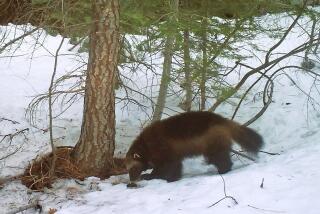Fish and Wildlife drops proposal to list wolverine as threatened
The U.S. Fish and Wildlife Service on Tuesday withdrew its proposal to list the wolverine as a threatened species in the contiguous United States. The agency said its earlier research, which concluded that climate change was destroying the snow-loving mammal’s alpine habitat, had been premature.
Fish and Wildlife Service biologists had recommended the protection based on research suggesting that climate change is likely to destroy the near-arctic conditions where the remaining 300 animals in the Lower 48 states exist. Wolverines continue to thrive in Canada and Alaska.
“This decision has been a complex and challenging one to make,” said the agency’s director, Dan Ashe. “If new information emerges that suggests we should take another look at listing, we will not hesitate to do that.”
Conservation organizations accused the agency of yielding to pressure from states where most of the animals are still found: Montana, Idaho and Wyoming. The states question the reliability of climate change predictions and warn that granting federal protections would hurt recreation and development in alpine terrain that is managed by local authorities.
Jeff Copeland, a spokesman for the nonprofit Wolverine Foundation and a retired U.S. Forest Service biologist, said Fish and Wildlife biologists “spent seven years putting together a compelling argument for protection under the Endangered Species Act. Now the agency says, ‘Oops! We changed our mind.’ But they simply chose to not accept the science.”
Noah Greenwald, endangered species director at the Center for Biological Diversity, says federal scientists and independent biologists know the wolverines are threatened. “The only ones denying that grim reality are those making this decision to call off protections,” Greenwald said.
However, Ashe says that wolverine populations in the United States have been expanding since the late 19th century, when they were hunted and trapped to the edge of extinction, and that the available habitat can support larger numbers.
For example, a lone wolverine was spotted in the Sierra Nevada range in California in 2008, and another in Colorado in 2012, Ashe said. In April, a wolverine was seen in the Uinta Mountains of Utah — the first confirmed sighting in that state in three decades.
Asked about the sightings, Copeland said that wolverines could be expanding their range “not because the population is growing, but instead because habitat has been degraded elsewhere.”
Noreen Walsh, a biologist and Fish and Wildlife Service director for the region that includes Wyoming and Montana, initially supported the protections recommended by agency scientists, whose findings in early 2013 were later validated by an independent panel of biologists.
In May, Walsh ordered a reversal of the recommendation, citing uncertainties “about the degree to which we can reliably predict impacts to wolverine populations from climate change,” according to agency documents.
In July, dozens of the nation’s leading conservation scientists launched a letter-writing campaign urging the agency to uphold the recommendation because climate change is reducing habitat and spring snowpacks for building sheltered dens to raise wolverine kits.
On Tuesday, Ashe supported Walsh and two other regional directors who he said “conducted a fair, unbiased and objective look at the same set of facts and came up with a different interpretation.”
“We could not conclude the wolverine is in danger of extinction in the foreseeable future,” he said.







